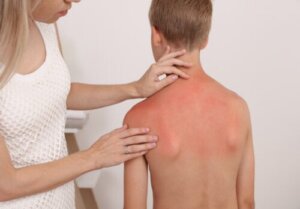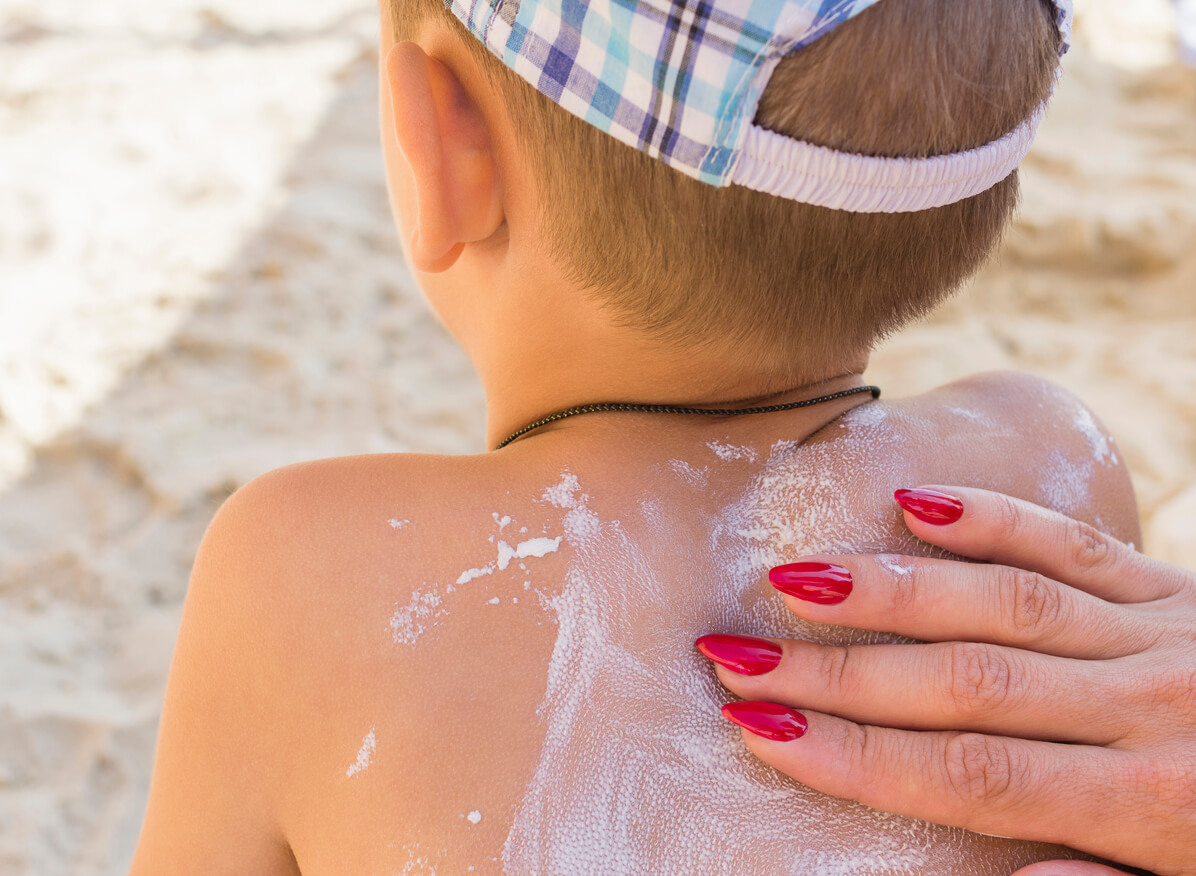Sunburn in Infants and Children: What You Should Know


Written and verified by the dermatologist Maria del Carmen Hernandez
Sunburn in infants and children can manifest itself through skin lesions in the future. Therefore, prevention of damage caused by ultraviolet rays from an early age is essential. From the use of adequate sunscreen to sunscreen clothing, it’s important to take preventive measures.
Types of sunburn
Sunburn in infants and children is caused by excessive exposure to ultraviolet rays without proper protection. Therefore, the greatest risk factor is the amount of time of exposure to the sun, not the intensity.
Mild sunburn
Mild sunburn usually causes tenderness and redness in the affected areas. After sun exposure, the skin surface may become red in as little as 30 minutes and then continue to flake and itch for several weeks.
Severe sunburns
More severe sunburns result in blistering. In addition, there’s greater intensity of pain and discomfort. Some of the symptoms include the following:
- Weakness
- Chills
- Nausea
- Fever
- Vomiting
Sunburn poisoning is also an extreme manifestation of UV damage. It’s characterized by swollen or reddened skin, lethargy, breathing that’s faster than normal, and irritability.
You may be interested in: Myths and Truths About Sun Protection for Children

Steps to prevent sunburn in infants and children
Preventing sunburn in infants and children is simple and easy. The application of broad-spectrum sunscreen with SPF should be at least 30 minutes before sun exposure and then every 2 hours. It’s always best to choose a sunscreen that’s water resistant and in a formulation that’s easy to apply to children, such as spray or cream.
There are additional protective barrier methods such as clothing with UPF (ultraviolet protection factor). According to studies published by the Journal of Cutaneous Medicine and Surgery, the UPF of a fabric depends on the fiber content, the weave, and the color of the fabric.
Try to avoid direct sun exposure between the most harmful times, from 10 am to 4 pm. However, children under 6 months of age are prohibited from direct sun exposure due to their sensitive skin. In addition, the use of sunscreen isn’t advised for newborns. Rather, physical methods or baby-friendly products should be used.
Sunburn treatment
In most cases, sunburn in infants and children tends to resolve on its own, without requiring any intervention. In addition, it’s important to keep in mind that the best way to alleviate symptoms is to avoid sunburn in the first place. However, certain recommendations from the American Academy of Dermatology Association can be followed:
- Drink plenty of water to avoid dehydration.
- Cold colloidal oatmeal baths may help soothe the skin in mild burns.
- Gels or creams with aloe vera soothe burning.
Sunburns can vary from mild to severe depending on the degree of exposure to the sun’s ultraviolet rays. In addition, blisters shouldn’t be popped but rather allowed to run their physiological course. In infants or children, a moisturizing lotion can be used to soothe the redness and local temperature. In fact, calamine is a very effective component found in dermatological products.
Read also: 10 Most Common Skin Conditions in Babies

Sunburn and skin cancer
The increase in the number of sunburns a child has is directly related to the risk of skin cancer. They’re even the most frequent tumors and in recent years, there has been a clear increase in cases.
Sunburns in babies and children can be annoying and painful, as well as cause concern by increasing the lifetime risk of developing melanoma.
Prevention first
It goes without saying that prevention is the best medicine. Therefore, it’s advisable, from an early age, to use sunscreen greater than or equal to 50 that provides broad-spectrum protection.
Sunscreen should be reapplied after two hours or after having been in the sea or swimming pool. In addition, physical protection methods such as the use of sunglasses, hats, or clothing with an Ultraviolet Protection Factor are of great importance.
Sunburn in infants and children can manifest itself through skin lesions in the future. Therefore, prevention of damage caused by ultraviolet rays from an early age is essential. From the use of adequate sunscreen to sunscreen clothing, it’s important to take preventive measures.
Types of sunburn
Sunburn in infants and children is caused by excessive exposure to ultraviolet rays without proper protection. Therefore, the greatest risk factor is the amount of time of exposure to the sun, not the intensity.
Mild sunburn
Mild sunburn usually causes tenderness and redness in the affected areas. After sun exposure, the skin surface may become red in as little as 30 minutes and then continue to flake and itch for several weeks.
Severe sunburns
More severe sunburns result in blistering. In addition, there’s greater intensity of pain and discomfort. Some of the symptoms include the following:
- Weakness
- Chills
- Nausea
- Fever
- Vomiting
Sunburn poisoning is also an extreme manifestation of UV damage. It’s characterized by swollen or reddened skin, lethargy, breathing that’s faster than normal, and irritability.
You may be interested in: Myths and Truths About Sun Protection for Children

Steps to prevent sunburn in infants and children
Preventing sunburn in infants and children is simple and easy. The application of broad-spectrum sunscreen with SPF should be at least 30 minutes before sun exposure and then every 2 hours. It’s always best to choose a sunscreen that’s water resistant and in a formulation that’s easy to apply to children, such as spray or cream.
There are additional protective barrier methods such as clothing with UPF (ultraviolet protection factor). According to studies published by the Journal of Cutaneous Medicine and Surgery, the UPF of a fabric depends on the fiber content, the weave, and the color of the fabric.
Try to avoid direct sun exposure between the most harmful times, from 10 am to 4 pm. However, children under 6 months of age are prohibited from direct sun exposure due to their sensitive skin. In addition, the use of sunscreen isn’t advised for newborns. Rather, physical methods or baby-friendly products should be used.
Sunburn treatment
In most cases, sunburn in infants and children tends to resolve on its own, without requiring any intervention. In addition, it’s important to keep in mind that the best way to alleviate symptoms is to avoid sunburn in the first place. However, certain recommendations from the American Academy of Dermatology Association can be followed:
- Drink plenty of water to avoid dehydration.
- Cold colloidal oatmeal baths may help soothe the skin in mild burns.
- Gels or creams with aloe vera soothe burning.
Sunburns can vary from mild to severe depending on the degree of exposure to the sun’s ultraviolet rays. In addition, blisters shouldn’t be popped but rather allowed to run their physiological course. In infants or children, a moisturizing lotion can be used to soothe the redness and local temperature. In fact, calamine is a very effective component found in dermatological products.
Read also: 10 Most Common Skin Conditions in Babies

Sunburn and skin cancer
The increase in the number of sunburns a child has is directly related to the risk of skin cancer. They’re even the most frequent tumors and in recent years, there has been a clear increase in cases.
Sunburns in babies and children can be annoying and painful, as well as cause concern by increasing the lifetime risk of developing melanoma.
Prevention first
It goes without saying that prevention is the best medicine. Therefore, it’s advisable, from an early age, to use sunscreen greater than or equal to 50 that provides broad-spectrum protection.
Sunscreen should be reapplied after two hours or after having been in the sea or swimming pool. In addition, physical protection methods such as the use of sunglasses, hats, or clothing with an Ultraviolet Protection Factor are of great importance.
All cited sources were thoroughly reviewed by our team to ensure their quality, reliability, currency, and validity. The bibliography of this article was considered reliable and of academic or scientific accuracy.
- Adam J. Sun-protective clothing. J Cutan Med Surg. 1998 Jul;3(1):50-3. doi: 10.1177/120347549800300115. PMID: 9677262. https://pubmed.ncbi.nlm.nih.gov/9677262/
- Dowd MD. Treatment and Prevention of Pediatric Sunburn. Pediatr Ann. 2019 Jun 1;48(6):e213-e214. doi: 10.3928/19382359-20190520-02. PMID: 31185109. https://pubmed.ncbi.nlm.nih.gov/31185109/
- Guerra KC, Urban K, Crane JS. Sunburn. 2020 Nov 20. In: StatPearls [Internet]. Treasure Island (FL): StatPearls Publishing; 2021 Jan–. PMID: 30521258. https://pubmed.ncbi.nlm.nih.gov/30521258/
This text is provided for informational purposes only and does not replace consultation with a professional. If in doubt, consult your specialist.








